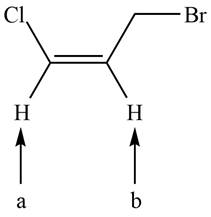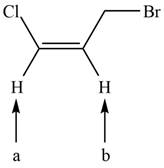
Concept explainers
(a)
Interpretation:
The number of peaks present in the given NMR signal of labeled proton is to be calculated.
Concept introduction:
In NMR spectrum, peaks are known as resonances, lines or absorptions. The number of NMR signal in a compound is equal to the number of chemically non-equivalent protons present in that compound. In
Answer to Problem 14.16P
The labeled proton splits into septet in NMR spectrum of the given compound.
Explanation of Solution
The given compound is
Where,
➢
➢
Here,
Substitute the value of
Hence, the labeled proton gives seven peaks in NMR spectrum.
The labeled proton splits into septet in NMR spectrum of the given compound.
(b)
Interpretation:
The number of peaks present in the given NMR signal of labeled proton is to be calculated.
Concept introduction:
In NMR spectrum, peaks are known as resonances, lines or absorptions. The number of NMR signal in a compound is equal to the number of chemically non-equivalent protons present in that compound. In
Answer to Problem 14.16P
The labeled proton (a), (b), and (c) splits into triplet, multiplet and quintet in NMR spectrum of the given compound.
Explanation of Solution
The given compound is
Where,
➢
➢
Here,
Substitute the value of
Hence, the labeled proton (a) gives three peaks (triplet) in NMR spectrum.
Proton (b) is bonded to one methylene group that has two hydrogen atoms and one methyl group that has three hydrogen atoms. The number of peaks is calculated by the formula,
Where,
➢
➢
Here,
Substitute the value of
Hence, the labeled proton (b) splits into a multiplet in NMR spectrum.
Proton (c) is bonded to two methylene groups that have four hydrogen atoms. The number of peaks is calculated by the formula,
Where,
➢
➢
Here,
Substitute the value of
Hence, the labeled proton (c) gives quintet in NMR spectrum.
Therefore, protons (a), (b), and (c) give
The labeled proton (a), (b), and (c) splits into triplet, multiplet and quintet in NMR spectrum of the given compound.
(c)
Interpretation:
The number of peaks present in the given NMR signal of labeled proton is to be calculated.
Concept introduction:
In NMR spectrum, peaks are known as resonances, lines or absorptions. The number of NMR signal in a compound is equal to the number of chemically non-equivalent protons present in that compound. In
Answer to Problem 14.16P
The labeled proton (a) and (b) splits into doublet and sextet in NMR spectrum of the given compound.
Explanation of Solution
The given compound is shown below.

Figure 1
There are two labeled protons, (a) and (b). Proton (b) is bonded to a carbon atom that has one hydrogen and one methylene group. The number of peaks is calculated by the formula,
Where,
➢
➢
Here,
Substitute the value of
Hence, the labeled proton (b) splits into a sextet in NMR spectrum.
Proton (a) is bonded to a carbon atom that has only one hydrogen atom. The number of peaks is calculated by the formula,
Where,
➢
➢
Here,
Substitute the value of
Hence, the labeled proton (a) gives two peaks (doublet) in NMR spectrum.
Therefore, protons (a) and (b) give
The labeled proton (a) and (b) splits into doublet and sextet in NMR spectrum of the given compound.
(d)
Interpretation:
The number of peaks present in the given NMR signal of labeled proton is to be calculated.
Concept introduction:
In NMR spectrum, peaks are known as resonances, lines or absorptions. The number of NMR signal in a compound is equal to the number of chemically non-equivalent protons present in that compound. In
Answer to Problem 14.16P
The labeled proton (a) and (b) splits into triplet, doublet and doublet in NMR spectrum of the given compound.
Explanation of Solution
The given compound is shown below.

Figure 2
There are two labeled protons, (a) and (b). Proton (a) is bonded to a carbon atom that has two hydrogen atoms. The number of peaks is calculated by the formula,
Where,
➢
➢
Here,
Substitute the value of
Hence, the labeled proton (a) gives three peaks (triplet) in NMR spectrum.
Both protons (b) are bonded to a carbon atom that has only one hydrogen atom. The number of peaks is calculated by the formula,
Where,
➢
➢
Here,
Substitute the value of
Hence, the labeled protons (b) give two peaks (doublet) in NMR spectrum.
Therefore, protons (a) and (b) give
The labeled proton (a) and (b) splits into triplet, doublet and doublet in NMR spectrum of the given compound.
Want to see more full solutions like this?
Chapter 14 Solutions
Organic Chemistry-Package(Custom)
- How many peaks are present in the NMR signal of the labeled protons of attached compound?arrow_forwardDetermining the Number of Peaks in an NMR Signal How many peaks are present in the NMR signal of the labeled protons of each compound?arrow_forwardHow many H NMR and C NMR signals are in each compound?arrow_forward
- Would the indicated hydrogens give the same H-NMR signal or different signals?arrow_forwardFor each NMR, label any and all triplets, singlets, etc. Propose a structure that matches each NMR spectrum.arrow_forwardHow many H-NMR signal can be detected in this molecule?Draw the H-NMR graph please.arrow_forward
 Organic Chemistry: A Guided InquiryChemistryISBN:9780618974122Author:Andrei StraumanisPublisher:Cengage Learning
Organic Chemistry: A Guided InquiryChemistryISBN:9780618974122Author:Andrei StraumanisPublisher:Cengage Learning
